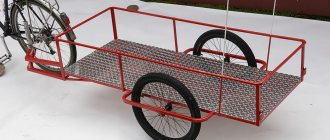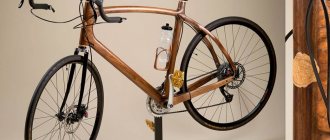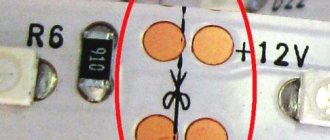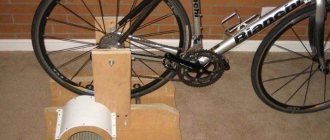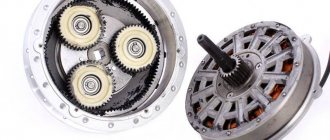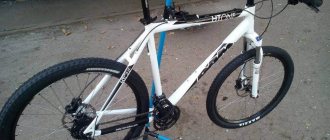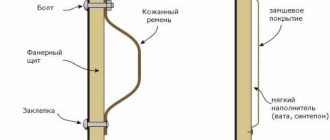Three years ago I bought a bike trailer that I used to take my son out for a walk. In principle, the trailer suited me with the exception of:
- The trailer is quite low. And although there is a small flag on it, which makes it more visible, drivers in traffic may not see it.
- Since the child is one meter away from me, I can’t see what he’s doing. You have to constantly turn your head, which is not very good while driving.
During a trip to Europe, I saw a large number of cargo bikes on the streets that were used to transport children. At first I thought about buying a cargo bike. But the price turned out to be too high and I decided to assemble the tricycle myself. Since this was my first self-assembled bicycle, during the assembly of the trike many situations arose that had to be solved by trial and error. But in the end I managed to make a cargo trike with my own hands. After searching the internet for a trike model to go with, I settled on the Christiania Trike. So, let's try to make a cargo tricycle ourselves!
History of origin
The very first pedicabs appeared several centuries ago. Japan is the birthplace of unusual transport - pedicabs appeared there at the turn of the 17th-18th centuries. At that time, they were carts on wheels, pulled by cabs (rickshaws). The influence of Western culture on the life of the Japanese could not have happened here. The pace of life in the cities grew rapidly, people needed to move much faster - palanquin bearers could not cope, and the use of horses cost a pretty penny. It is clear that at that time there was no question of any prefix “velo” - only walking or running.
This type of economical transport quickly gained popularity, and already in the second half of the 19th century, nimble carts were scurrying everywhere in the countries of South and East Asia. It wasn't until the 20th century that someone came up with the great idea of combining a bicycle with a cart to create a more convenient means of transportation that would move even faster. And the driver won’t get tired so quickly. This is how the rickshaw appeared - a bicycle carriage that also attracted the attention of residents of other continents.
Of course, such transport cannot compete with cars, but today in many countries that are attractive from the point of view of tourists, riding a rickshaw is one of the most popular entertainments. Thus, bicycle taxis are incredibly popular in the central part of New York, London and Washington. A few years ago, the curiosity reached the Russian capitals - in Moscow, pedicabs travel along Pushkinskaya Square, and in St. Petersburg, along Dvortsovaya.
Each country that introduced pedicabs brought something different to the designs and design. In particular, you can notice that Asian models differ significantly from Russian or European designs. Thus, in Western countries they prefer to use three-wheeled bicycle taxis: in them the driver is in front, and 2-3 passengers are in the back. Such carts come in open and closed types. Resourceful Vietnamese prefer to show tourists sights in what is called a “face” - the passengers are located in front, and the driver is in the back, “pushing” the cart in front of him. In Mongolia and China you can see four-wheeled pedicabs.
And in Russia, the production of unusual vehicles was established several decades ago. The first domestically produced pedicabs came out of the Armavir plant in the Krasnodar Territory. Russian engineers have figured out how to reduce the load on the driver. Installing solar panels ensures the operation of the electric motor - now the driver does not need to pedal furiously. Instead, he can better keep his eyes on the road and admire the surrounding landscapes along with tourists.
After the introduction of electric pedicabs, new ideas for using an unusual vehicle began to appear. Recently, pedicabs for transporting ice cream, soft drinks, and even rickshaw bars in resort towns were presented.
What does a rickshaw look like?
A pedicab is a vehicle for public or personal use that can carry 1-2 people, excluding the driver. Most of all, it resembles a tricycle, in one of which there is a stroller (seat), and passengers are transported on it. The driver controls the rickshaw by pedaling, that is, this type of transport is 100% environmentally friendly. In most cases, there is a small fabric canopy over the passenger seat, which helps to hide from the scorching sun. The use of this transport is possible only in the warm season.
Manufacturing instructions
Master class on how to make a tricycle step by step:
- The donor model is placed on the platform with the steering wheel down.
- Remove the wheels, remove rust and other defects in visible places.
- Saw off the rear part of the unit with a grinder.
- The differential is fixed using metal clamps.
- The bridge is installed at 90 degrees using the above method.
- The remaining auxiliary elements are secured by welding.
- The wings are mounted, between which a basket of suitable size is welded.
- Install two rear rims in parallel.
- The fasteners of the clamps are tightened.
- One is made from two circuits and then installed.
- Equip the brake unit using disc parts and a switch on the steering wheel.
- They check the build quality and paint the model.
Homemade tricycles may vary in size depending on the user's creative ideas. A proven, fast and reliable method in terms of technology is the use of a UK-65 type rear differential axle. When creating a drawing of a homemade tricycle, you should take into account the costs of consumables.
When creating the modification in question, you will need to take into account the costs of purchasing the necessary parts yourself. In addition to the bridge, you will need a chain, a speed switch, wheels, and a set of sprockets. Also, we must not forget about lubricating and painting sanded and welded surfaces.
Required materials and tools
To make a three-wheeled trike from a bicycle, you should stock up on the following equipment:
- a pair of chains;
- cables for the brake and speed switching units;
- standard bicycle;
- stainless steel clamps;
- wheels;
- wings;
- brake block;
- basket for transporting cargo;
- steel frame;
- paint and varnish composition.
To create a tricycle with your own hands, you will need a hammer, an angle grinder, a welding inverter, a drill, and a set of keys. After sketching all the drawings and diagrams, you should prepare the specified materials and tools in advance. If you plan to build a spacious luggage compartment, additionally prepare sheets of plywood and a hacksaw. If desired, the unit is equipped with an alarm bell or horn. Comfortable seating is ensured by installing a new seat or installing a special cover.
Some craftsmen place a compact basket at the front of the structure for transporting bags and packages. At the same time, your hands are completely free while riding.
Option 2: assembling a moped with a gas engine
This is an advanced method, and the result is more reminiscent of a real moped. To make it, we need:
- gasoline engine;
- moped parts: wheels, shock absorbers, exhaust pipe, brakes;
- proven bike frame;
- tools.
Since here we are going to get a real moped, the frame must have increased strength and weight. Also, mopeds have a slightly different frame design, which may require some modifications.
Wheels from a moped are put on the frame. It will be necessary to change the fork design, since the width of the wheels will be wider than the distance between the dropouts. If possible, install shock absorbers on the fork.
Carefully overhaul the moped power unit and replace all faulty parts. The propulsion system will require a separate space; for this, a welded metal platform at the bottom of the frame would be a good option. The engine and fuel tank are secured to the site using metal fasteners. It is better to place the battery closer to the steering wheel. An exhaust pipe is connected to the bottom of the engine. The pipe must be firmly secured to the frame so that it does not dangle while driving.
Transmission. Next, you will need to make the engine torque transmission system:
- Remove the pedals and chainring from the bicycle frame.
- Install sprockets on the rear wheel of the moped and the engine shaft. A star on a wheel with a larger diameter.
- Place the rear wheel on the frame.
- Connect the stars using a chain.
Motor connection. The clutch and throttle valve are connected to the ignition lever via drive cables. The tension is selected so that the engine can immediately start and start spinning the wheel.
Brakes. If only one brake (for example, the front brake) may be sufficient for a bicycle, then it is better to play it safe and install them on both wheels. The rear one can be used as the main one, and the front one as an auxiliary one, to adjust the speed.
In general, a homemade moped based on a bicycle will look like this:
Converted bike
Since a vehicle equipped with an engine moves faster than a regular bicycle (this is why the modification is intended), for safety reasons it is necessary to install lighting devices on it. Personal protective equipment – helmet, knee pads and special shoes.
Basis for three-wheeled transport
To make your own tricycle a good-quality, reliable and durable one, it is advisable to stock up on the following parts:
- Making your own bike from scratch is the factory’s job, not yours. Therefore, take a leading two-wheeled bicycle bike as a basis; for a child, a small one is suitable; for an adult, a large one should be taken.
- A kit consisting of tools that can usually be used to repair a bicycle.
- One more, third wheel for a bicycle. Please note that all rims must be in good condition.
- Chain links, rear hub with additional sprocket, brake set and clamps.
- An axle that is located at the rear, preferably with a differential.
Electric bike
Factory models are reliable and quite comfortable, but their main disadvantage is their high cost. Its reduction occurs due to the use of cheap components, which does not have the best effect on the quality of the bike. A two-wheeler with an engine, as a rule, weighs at least 20 kg, so if it breaks down, moving long distances while pedaling can be very problematic. An engine installed on the bike yourself avoids this problem. In addition, modern stores offer enough ready-made solutions that allow you to make an electric bike yourself and turn an ordinary bicycle into an engineering miracle. Such alteration does not require deep technical knowledge and can be done by anyone.
Preparatory stage
To create a tricycle with your own hands, you need to purchase a standard analogue with a pair of rims. This may be a foreign or domestic modification. Taking into account the chosen configuration, the aesthetic part of the future transport will be designed. It is necessary to take into account the quality of parts and the possibility of transforming the unit.
Initially, all design diagrams and drawings should be completed. Particular attention is paid to:
- Stability, which requires correctly calculating the placement of the rear wheels.
- Height of the steering column and seat. The parameter is calculated taking into account the characteristics of a particular person.
- Purchase of a rear axle with differential. The element is responsible for comfortable movement and safe driving.
- Adjusting the steering unit. A homemade tricycle should not fall over when turning.
- High-quality brake block, signal horn.
- Smooth movement of the steering wheel and wheels. There should be no creaks or other extraneous sounds.
In the drawings of a tricycle, the most crucial moment is modifying the frame configuration. It will be necessary to strengthen the metal profile using stiffeners. As an option, it is possible to use a design from Ural. The rear axle is cut down and an updated frame made of duralumin pipes is installed. The second part is installed in the lower section, it is used for transporting goods. Wheels are placed on both sides of the axle, and a sprocket is fitted in the center.
DIY tricycle drawing
HOW TO MAKE A TRI-WHEELED BICYCLE
Tricycle from. two-wheeled
How to turn an old two-wheeled bicycle into a three-wheeled one with a cargo trolley?
Naturally,
that this is a troublesome task and will require certain technical skills, available materials and spare parts. Not to mention the ingenuity. What is needed here are men's hands capable of turning this idea into reality.
Here is the kinematic diagram of a tricycle (see Fig. 1).
Rice. 1. Drive diagram of a tricycle with one drive hub: 1 – front wheel 2 – drive to the driven sprocket of the rear wheel 3 – rear hub with an additional sprocket on the body 4 – chain drive to the axle shaft of the rear wheel 5 – driven rear wheel 6 – free rear wheel progress.
The pedal chain drive operates on the driven sprocket of the rear hub mounted on the frame. An additional chain drive sprocket is riveted onto one of the flanges of the hub body, which drives the axle shaft of one of the rear wheels to rotate. To do this, a sprocket is firmly mounted on the axle shaft, similar to the additional sprocket of the hub body.
The proposed design uses any commercial hub - both single-speed and multi-speed, both brake and non-brake. In the latter case, in addition to the brake on the front wheel, the free rear wheel is equipped with a brake of any type.
Some craftsmen have developed several types of cargo bicycle chassis, shown in Fig. 2. The bicycle on the right is designed for transporting various types of cargo and is indispensable for summer residents and gardeners, and on the left is a bicycle with a cargo trolley, easily converted into a seat for a passenger.
Abroad, for example, people are interested not so much in bicycles for transporting goods, but in “passenger” bicycles, “tricycles” for walking, for moving the elderly. Pedicars are interesting - tricycles - fairly light machines with a three-speed gearbox, differential, and effective wheel suspension. Often, in addition to canopies and awnings, designers also provide their three-wheeled vehicles with an addition to the pedal drive - a manual drive.
Comments: 1
Purpose
It would seem that the advent of cars should have eliminated the need to use bicycle carts. But it was not there! Pedicabs to this day remain one of the most popular transport in tourist countries. But it is not only foreign guests that determine their popularity. The undeniable advantages of using a bicycle taxi are the following:
- environmental friendliness;
- exoticism;
- budget;
- wide range of use;
- high self-sufficiency.
Why do you need a velomobile?
The velomobile has characteristics that a regular bicycle does not include in its functionality:
You can sit comfortably on the velomobile by installing a soft, comfortable chair; Another huge advantage of a velomobile is that when riding it, the lion's share of the muscles in the lower body sways. And these are legs, hips, and abs. If you do everything correctly, you can include other muscle groups in action to look beautiful and fit. A velomobile is also needed by those who burn with happiness, accelerating at incredible speeds.
The most important thing at this point, right, is to install all the structural details. In addition to the above-mentioned advantages of this type of transport, a velomobile will also come in very handy for people who like to ride around the city or beyond, breathing deeply in fresh air and freedom.
The nuances of installing the brake system
After carrying out the above manipulations, the assembly of the equipment can be considered complete. Special attention should be paid to the brake assembly and axle. Only a disc system is suitable for an adult tricycle; a rim analogue cannot be installed correctly. The unit will require additional financial investments to ensure that further operation of the product is safe for the cyclist and others. The kit includes discs, hubs, calipers, and a manual control lever.
No particular difficulties are expected during the installation of the bridge. The unit aggregates with most classic frames. First, all the standard parts of the rear part are dismantled (chain, wheel with fender, trunk, hand brake). A type of UK category bridge is mounted on the rim mounting compartment. The stops are inserted behind the lower pipe of the rear frame part, the axle is threaded through special eyes. The elements are securely tightened, the mating parts are fixed using clamps. At the next stage, an extended chain is installed, made from two standard analogues by removing excess links. For this purpose, the method of grinding off a rivet or installing a new lock is used. Then the speed switch is adjusted.
The future owner of a tricycle, assembled independently, can build the device without significant financial costs, decorating the equipment according to his preferences with an original design. As a result, the user will receive not only a personal exclusive bicycle machine, but also an assistant for transporting food and other items. Experts recommend regularly lubricating rubbing parts, as well as monitoring other structural elements.
Why do you need this?
First of all, you should think about what the bicycle equipped with an electric motor will be used for. It will become heavier, it will be impossible to do cross-country and downhill riding on it, because the center of gravity of the system increases, the weight increases, and besides, it’s not worth falling on such a bike. This may damage the motor and require replacement.
Generally, an electric bike is required for the following:
- power reserve “just in case”, in case of fatigue, for reserve. This is a very good solution for older amateur cyclists, as well as for people suffering from cardiovascular diseases and obesity. This allows you to go on quiet walks without the danger of exhaustion on the way back if you can’t time them correctly;
- constant use for climbing hills, in the form of connection on difficult sections of the route. To do this, an electric bicycle must be able to move on two energy sources at once: muscle power and an engine.
It is better not to use an electric bike on rough terrain. His destiny is country paths and asphalt pavement. Also, the electric bike does not like jumping.
Deciding on power
The key factors will be:
- the power of the engine, which is located around the wheel hub (the speed and traction qualities of an electric bicycle depend on it);
- battery capacity. The time of autonomous skating and the weight of additional equipment, which usually does not exceed 10 kilograms, depend on it.
Of course, you can include additional data in the evaluation list, for example, the number of battery recharges (resource), time spent on full charging and many other indicators.
Much depends on the weight of the cyclist. A teenager weighing 50 kg and an overweight man weighing 125 kg apparently need different sets.
